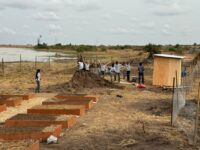
The goal: Safe food for every home | Virginia Tech News
It was a blisteringly hot day, near 100 degrees Fahrenheit — normal, though, in March for Kpone Katamanso, Ghana.
Sweat dripped and combined with dirt, building the texture we all know from days working in the garden. Chicago maroon T-shirts – and even a few emblazoned with “4 The Soil” – scattered the backdrop along with the smiles group members wore while covered in the sweat and soil.
The group carefully, but excitedly, constructed a community garden for the community of Katamanso. While commonplace in the United States, community gardens are relatively new to Ghana.
The shared goal of safe food for every home united every person in the community and is what brought two Virginia Tech students to Ghana during spring break in March.
With a passion for food sovereignty and food security for all, Mary Michael Lipford Zahed, a graduate student in the School of Plant and Environmental Sciences at the Eastern Shore Agricultural Research and Extension Center, and Megan Pollok, a senior in the College of Agriculture and Life Sciences, built upon Zahed’s expertise and experience to help a global community.
“We wanted to find out the needs of this specific community and work from there,” Zahed said. “While most of us involved with the project had worked in Ghanaian communities before, this was a new area of the country for us. We learned about the community needs and the space so that this would be something that the people could maximize to help their lives and community excel.”
The community garden plans were developed in conjunction with Jeanette Ankoma-Sey, a Ghanaian-American professional landscape designer in Northern Virginia, and Virginia Tech horticulture alumni.
The design used feedback from the community to be able to help family members produce enough food for their families – specifically, foods they would enjoy and look forward to eating, such as okra, tomatoes, hot peppers, and carrots.
“Every step of the way, we made sure that this garden is something that is sustainable,” Zahed said. “Every decision we made was intentional and made jointly with the Katamanso community so that they were a part of the process from day one.”
The community garden needed to be truly theirs, she said.
“I learned about this in the classroom, but how do I create this and make this a project that’s sustainable?” Pollok said. “Sometimes, when we think about doing work in communities, we have an idea in our mind about what that should look like. This project helped me to see that really at the forefront of everything, you must keep the community members in mind and ask what they need and what you can do for them.”



